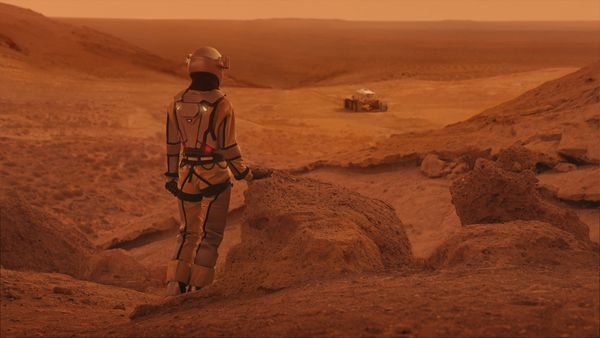What would colors look like on other planets?

The human brain is remarkably good at adjusting to different light conditions. Think about wearing a pair of tinted sunglasses: At first, the tint is noticeable, but after a while, colors begin to look "normal" again.
This also happens naturally as we age. The lenses of older people's eyes become progressively more yellow compared with when they were younger. However, they don't see colors that way, because their brains correct for the difference.
But how would your brain adjust to colors in a completely novel environment — one that didn't exist on Earth? Here's how colors might look on other planets, according to experts.
"Whatever the average color is, that's going to end up looking gray," Michael Webster, a cognitive vision scientist at the University of Nevada, Reno, told Live Science.
According to Webster's research, the same mechanism that corrects yellowed lenses and tinted sunglasses is likely to kick in when astronauts travel to another planet someday. Depending on what the predominant colors are in their new environment, a space explorer's brain will readjust to perceive them more neutrally. Take Mars, for example.
Related: What color is the sunset on other planets?
"My prediction is that when people move to Mars, the Red Planet is not going to look red to them over time," Webster said. Instead, the rusty Martian terrain will begin to look browner or grayer. And the ocher Martian sky will start to appear bluer — not the same blue as Earth's, but significantly less orange than it appears to us now.
Breaking space news, the latest updates on rocket launches, skywatching events and more!
This doesn't mean every alien sky would look blue to us over time, though. It would depend on the predominant color of the light coming through the atmosphere in relation to the predominant colors of the landscape. The opposite of orange on the color wheel is blue, so those cooler tones would likely become more prominent as the observer's brain moved toward neutral. But if you could travel to an exoplanet with purple vegetation and a gold sky, for example, your brain might adjust differently.
Your mental color filter isn't limited to hue; it also adjusts for intensity. On a planet with a limited natural color palette, your brain would become attuned to very subtle changes in shade; over time, you would view washed-out colors as more vibrant, and vice versa. "If you lived in a super colorful environment, you would actually turn down that 'knob,'" Webster said. After moving back to Earth, your mental color knobs would eventually return to factory settings.
But what if, instead of waiting for astronauts' eyes and brains to adjust to a new planet, we invented a device that automatically filtered the environment for them? Derya Akkaynak, an engineer and oceanographer at the University of Haifa in Israel, and her lab are working on a similar problem. But her research stays a little closer to home — in marine environments, rather than outer space.
Akkaynak co-developed a computer algorithm called "Sea-thru," which color-adjusts images and videos taken underwater to make them look as if they were taken on land. The first step is to correct water's natural blue filter.
Even on another planet, pure bodies of water would appear blue. That's because water partially filters out other colors of visible light. "Basically, it changes white light to become blue," Akkaynak said.
But most bodies of water are not pure. Instead, they are full of salt particles, green phytoplankton, sediments and other stuff that bounces light particles, or photons, around. For that reason, objects appear different colors depending on the depth and type of water they are viewed through. Akkaynak's model considers these factors to adjust images to a terrestrial perspective.
Hypothetically, if you knew the composition of an alien planet's atmosphere and oceans, you could predict how light would interact with it. Then, you could use that information to create an algorithmic filter "correcting" the environment's colors — which could be installed in, say, the visor of a spacesuit.
Until humans actually go to another planet, though, it's impossible to say exactly how the process of adjusting to an alien color palette might feel. But once again, the deep sea might offer a good approximation. Akkaynak once traveled to underwater depths past 100 feet (30 meters), deep enough for all of the red light to be filtered out.
"Everything looked yellow, not blue, probably because I was trying to compensate for the lack of red," Akkaynak told Live Science. "But generally, it looked crazy."

Joanna Thompson is a science journalist and runner based in New York. She holds a B.S. in Zoology and a B.A. in Creative Writing from North Carolina State University, as well as a Master's in Science Journalism from NYU's Science, Health and Environmental Reporting Program. Find more of her work in Scientific American, The Daily Beast, Atlas Obscura or Audubon Magazine.

